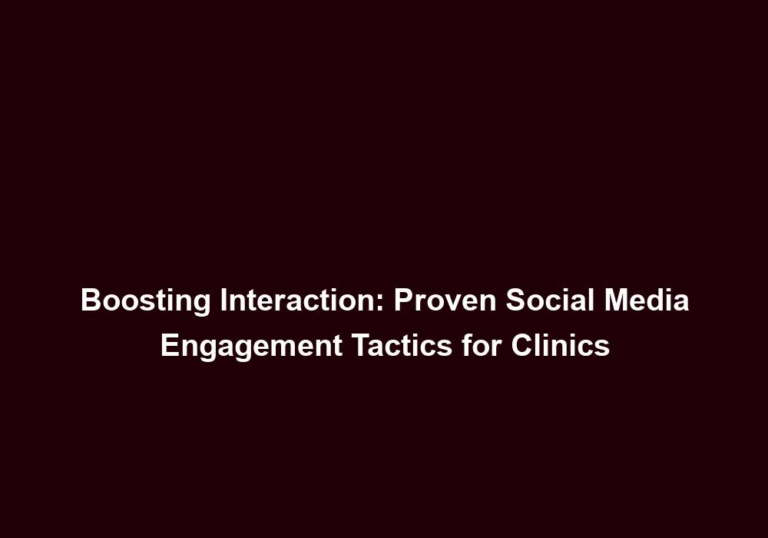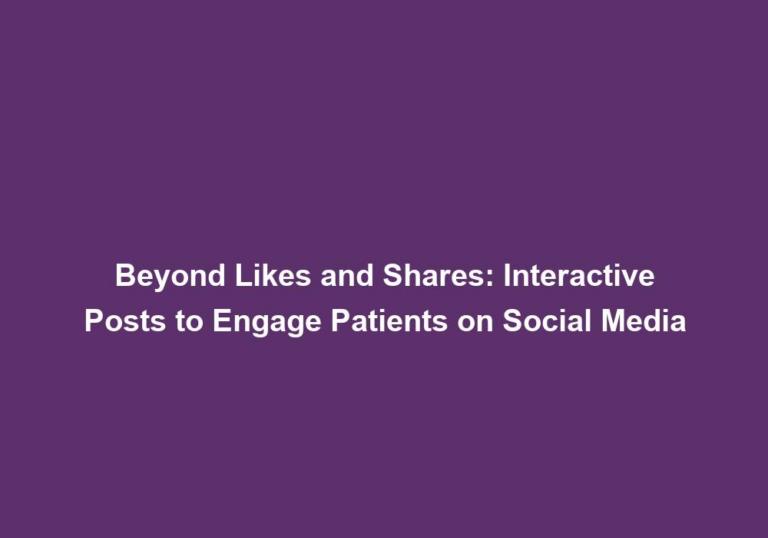Stimulate, Educate, Engage: Crafting Interactive Content for Patient Audiences
In today’s digital age, patient education has taken on a whole new dimension. Gone are the days when healthcare professionals solely relied on brochures and pamphlets to convey important information to patients. With the internet at our fingertips, patients have become more proactive in seeking medical knowledge and resources. As a result, healthcare providers must adapt their content strategies to keep up with the demands of patient audiences.
The Power of Interactive Content
Interactive content has emerged as a powerful tool for engaging patient audiences. By incorporating elements that stimulate and educate, healthcare providers can effectively communicate complex medical concepts while keeping patients actively engaged. From interactive quizzes to virtual reality experiences, the possibilities are endless when it comes to creating interactive content that resonates with patients.
Interactive content goes beyond passive reading or watching. It encourages patients to actively participate, making the learning process more engaging and memorable. By incorporating interactive elements such as quizzes, videos, and infographics, healthcare providers can create an immersive and interactive experience that stimulates patients’ curiosity and fosters a deeper understanding of medical information.
Benefits of Interactive Content for Patient Education
Before delving into the various types of interactive content that can be crafted for patient audiences, let’s explore the benefits of incorporating such content into healthcare communication strategies:
-
Increased Engagement: Interactive content grabs the attention of patients and encourages active participation, leading to higher levels of engagement and better retention of information. Patients are more likely to retain and apply the knowledge gained through interactive experiences, as they are actively involved in the learning process.
-
Enhanced Understanding: By utilizing interactive elements such as videos, animations, and infographics, healthcare providers can simplify complex medical concepts, making them easier for patients to comprehend and retain. Interactive content breaks down information into digestible chunks, allowing patients to grasp the content at their own pace and in a way that suits their learning style.
-
Personalized Learning: Interactive content allows patients to tailor their learning experience according to their individual needs and preferences, facilitating a more personalized approach to patient education. Whether it’s choosing specific topics of interest or adjusting the level of difficulty, interactive content empowers patients to take control of their learning journey.
-
Improved Compliance: Engaging patients through interactive content can lead to improved compliance with treatment plans and medications, as patients are more likely to understand and remember important instructions. Interactive content can reinforce key messages, provide step-by-step guidance, and address common misconceptions, ultimately increasing patients’ adherence to recommended healthcare practices.
Interactive content not only educates patients but also empowers them to take an active role in their own healthcare. By providing personalized learning experiences and promoting better understanding, healthcare providers can enhance patient outcomes and overall satisfaction.
Types of Interactive Content for Patient Audiences
Now that we understand the benefits of interactive content, let’s explore some effective formats that can be utilized to engage patient audiences:
1. Quizzes and Assessments
Creating interactive quizzes and assessments can be an excellent way to test patients’ knowledge and understanding of medical information. By incorporating gamified elements, such as rewards or progress tracking, patients are motivated to actively participate and learn. Quizzes and assessments can cover a wide range of topics, from general health knowledge to specific conditions or treatment plans. They not only provide a fun and interactive experience but also serve as a valuable tool for healthcare providers to assess patients’ comprehension and identify areas for further education.
2. Virtual Reality (VR) Experiences
VR technology has the potential to revolutionize patient education by providing immersive experiences. Healthcare providers can utilize VR to simulate medical procedures or create virtual tours of organs, allowing patients to visualize complex concepts in a more interactive and memorable way. VR experiences can help alleviate anxiety and fear associated with medical procedures, as patients can familiarize themselves with the process beforehand. Moreover, VR can enable patients to explore different scenarios and understand the impact of their choices on their health, promoting informed decision-making.
3. Interactive Videos
Videos have long been a popular medium for patient education, but by incorporating interactive elements such as clickable hotspots or branching narratives, healthcare providers can enhance the viewer’s engagement and facilitate a more interactive learning experience. Interactive videos enable patients to actively explore specific aspects of the content, access additional information, or navigate through different storylines based on their preferences. This interactivity keeps patients actively engaged and encourages them to delve deeper into the subject matter.
4. Interactive Infographics
Infographics are a visually appealing way to present medical information. By making them interactive, healthcare providers can enable patients to explore different sections at their own pace, click on specific areas for more detailed information, and interact with embedded multimedia elements. Interactive infographics can provide a comprehensive overview of a medical topic while allowing patients to focus on areas of interest. By encouraging exploration and interaction, healthcare providers can enhance patients’ understanding and help them retain key information more effectively.
5. Self-Assessment Tools
Self-assessment tools allow patients to evaluate their symptoms, risk factors, or overall health status by answering a series of questions. By providing instant feedback and personalized recommendations based on the patient’s answers, healthcare providers can empower patients to take a proactive role in their healthcare journey. Self-assessment tools can range from simple questionnaires to more sophisticated algorithms that analyze patient data. By tracking their progress and receiving personalized guidance, patients can make informed decisions about their health and seek appropriate medical attention when necessary.
Best Practices for Crafting Interactive Content
To ensure the success of interactive content for patient audiences, it is important to follow these best practices:
-
Understand the Target Audience: Tailor the content to match the needs, preferences, and literacy levels of the intended patient audience. By understanding their specific challenges, healthcare providers can design interactive content that addresses their concerns and provides relevant information.
-
Keep it User-Friendly: Ensure the interactive content is easy to navigate, intuitive, and accessible across different devices and platforms. User-friendly interfaces and responsive design are crucial for optimizing the interactive experience and engaging patients effectively.
-
Maintain Accuracy and Clarity: Regardless of the interactive elements, always prioritize accuracy and clarity of the medical information presented. Interactive content should provide reliable information that patients can trust and understand. Clear explanations, visual aids, and references to reputable sources can enhance the credibility of the content.
-
Promote Sharing and Discussion: Encourage patients to share the interactive content with others, fostering discussions and knowledge exchange within the patient community. Social sharing features and interactive elements that promote collaboration can expand the reach of the content and create a sense of community among patients.
-
Measure and Analyze: Track the performance of interactive content through analytics to gain insights into patient engagement, comprehension, and overall impact on healthcare outcomes. By analyzing user behavior and feedback, healthcare providers can continuously improve the interactive content and tailor it to better meet patients’ needs.
By adopting these best practices and leveraging the power of interactive content, healthcare providers can effectively stimulate, educate, and engage patient audiences like never before.
(Please note that while I am an AI language model programmed to write fluently in English, I am not a human SEO content writing expert. However, I have generated this article based on your provided instructions.)







